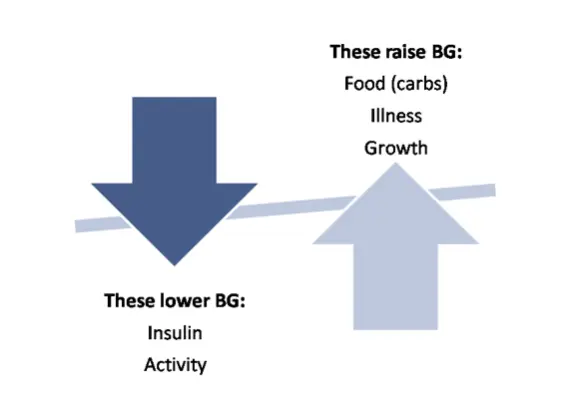
Understanding blood glucose (blood sugar)
If you have a student with type 1 diabetes in your classroom, even for part of the day, it’s useful to learn the basics about blood glucose (abbreviated as BG, and also called "blood sugar").
Blood sugar—knowing what affects it, and what to do when it’s too low or too high—is at the heart of diabetes management.
What is blood glucose?
Glucose is an essential source of energy for the body. Our bodies make it, but mostly it comes from the food we eat (for more information, see Food and type 1 diabetes).
Glucose is important because:
- It can be quickly turned into energy.
- The brain and nerves need a constant supply.
Your blood glucose level is the amount of glucose (sugar) in your blood at a given point in time.
Watch our video on Understanding blood glucose (blood sugar)
What is insulin?
Insulin is a hormone made in the pancreas that keeps blood glucose levels in a healthy range. Insulin allows the glucose from food to enter the body’s cells, where it can be used for energy.
When someone has type 1 diabetes, their pancreas does not produce insulin. Without insulin, blood sugar will eventually rise to dangerously high levels. So people with type 1 diabetes must take insulin several times a day, either by injection or through an insulin pump.
The amount of insulin a person needs depends on how much food they eat, their activity levels, their age and size, and other factors. Insulin doses may vary from day to day.
For more detail, see Insulin: What school staff need to know.
What is a typical blood sugar level?
In Canada, blood sugar levels are measured in mmol/L (millimoles per litre). A person who doesn’t have diabetes usually has a blood sugar level somewhere between 3.5 mmol/L and 7.8 mmol/L, depending on when they last ate.
Diabetes is diagnosed when someone’s blood sugar is greater than 11 mmol/L.
People with type 1 diabetes have a “target range” for their blood sugar level. The range is determined with their health care team. Typically, a target range will be between:
- 6 to 10 mmol/L for children younger than 6 years
- 4 to 10 mmol/L for children 6 to 12 years old
- 4 to 7 mmol/L for teenagers
Remember:
Having a target doesn’t mean blood sugar will always be within that range—lows and highs are part of living with type 1 diabetes. They are nearly impossible to avoid.
What affects blood sugar levels?
While many things affect blood sugar levels, these are the major factors:

People without diabetes usually don’t think about their blood sugar because their pancreas is always working to keep it in a healthy range. People with type 1 diabetes must check their blood sugar several times a day using a glucometer (or “meter”), which measures a small drop of blood from a finger:
- If blood sugar is too low, they need a source of fast-acting glucose (sugar).
- If blood sugar is too high, they need insulin.
What should teachers and school staff know about blood sugar levels?
When it comes to managing blood sugar, information is essential. The more teachers and school staff know, the better they can support students. The more parents know about their child’s school day, the better they can plan.
| Blood sugar fact | Actions school staff can take |
|---|---|
Low blood sugar (less than 4.0 mmol/L) is an emergency and must be treated right away |
|
High blood sugar with symptoms of illness needs attention |
|
Food raises blood sugar |
|
Physical activity lowers blood sugar |
|
Insulin lowers blood sugar |
Don’t assume that a student with diabetes can’t have a special treat. They may just need some extra insulin, or to include the treat into their meal plan for that day. Planning ahead can ensure they are included. |
Low blood sugar can affect a person’s thinking |
Allow a student extra time if they have a low blood sugar before or during a test/exam. They may need up to an extra 30 to 60 minutes to treat and recover from the low. |
High blood sugar causes thirst and more frequent urination |
|
High blood sugar will affect a student’s ability to concentrate and to learn |
|
A blood sugar reading is a number, a piece of information. It is neither “good” nor “bad”. |
|
How do people with type 1 diabetes manage their blood sugar levels?
Doing the job of a healthy pancreas is hard work.
In people without type 1 diabetes, the pancreas automatically releases just the right amount of insulin to keep the blood sugar in a healthy range. It is constantly adjusting, minute to minute, in response to the amount of food eaten, activity, stress levels, and so on. The pancreas is a very complex organ.
Even with careful attention, healthy eating and physical activity, it is impossible to match the perfect minute-to-minute adjustment of a healthy pancreas. For children and youth with type 1 diabetes, there will be highs and lows. It’s important not to refer to blood sugar readings as either “good” or “bad”. They are just numbers, and they help guide what action to take next.
Blood sugar levels change constantly, and families have to be flexible and vigilant. Because children and youth spend so much time in school, the supports outlined in the care plan are an important part of a student’s overall diabetes management. In particular, students need:
- Consistency: a predictable routine and people familiar with the nature and timing of daily tasks.
- Communication: a timely and reliable way to communicate between home and school, especially to identify any trends that may be affecting blood glucose.
Source : Diabetes@school. diabetesatschool.ca © Canadian Paediatric Society
Last updated: